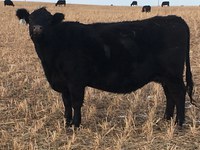NDSU Extension Offers Lessons in Basic Cow Economics
(Click the image below to view a high-resolution image that can be downloaded)
A big question for many cattle producers is how to make their operation more profitable.
“Cow-calf producers tend to operate on a fixed land/feed base associated with a substantial overhead cost in annual rents and finance payments,” says John Dhuyvetter, North Dakota State University Extension livestock systems specialist at the North Central Research Extension Center near Minot.
Key profitability drivers are the production of as many pounds of calf as possible to sell off the resource (land/feed) and capturing favorable market prices, he notes. Factors that contribute to the pounds produced are the calf crop percentage (low calf losses equate to more calves to sell), cow longevity (lower heifer retention equals more producing cows), calf weights (which are a function of genetics, age and nutrition) and stocking rate.
For the operation to be sustainable, the forage resource is limited in pounds and the animals it can support. Opportunities are available to enhance production through grazing systems and management that improves soil and moisture retention.
However, while simply overstocking and overutilization may improve output in the short term, they likely will diminish output through time. On a fully utilized land/feed resource, even selecting cows for added calf growth and weaning weights likely will not improve profitability.
“From a feed equivalency standpoint, differing numbers of cows of varied sizes weaning calves of different sizes generate the same market weight,” Dhuyvetter says.
For example, 88 frame score 4 cows each weighing 1,200 pounds and weaning 550-pound steer calves at seven months have roughly the same feed need and generate the same market weight as 75 frame score 7 cows each weighing 1,500 pounds and weaning 650-pound steer calves. The feed needs are similar for 83 frame score 5 cows each weighing 1,300 pounds and weaning 585-pound steer calves, and 79 frame score 6 cows each weighing 1,400 pounds and weaning 620-pound steer calves. With selection for higher milk production, which may increase weaning weight, stocking rates will be reduced further.
“If reproduction, calving loss, culling rate and market price are the same, there is no advantage to any size group,” Dhuyvetter says. “If, however, there is some adaption advantage, as seen in maintaining body condition, leading to better breed-back and calf survival, by some type or size group, an economic efficiency exists. Similarly, if the market discounts prices for some weight/size combination, that group will be economically disadvantaged.”
The market generally slides prices, paying more per pound for lighter calves; however, this may not reflect true value differences for some heavier calves capable of greater feeding efficiency and carcass value, he notes. That being the case, somewhat smaller calves appear to be favored until calf prices become discounted.
Along with the consideration of cow and feeder calf size is the potential value of the terminal crossing of larger sires with moderately smaller cows to maintain high cow numbers capable of producing greater weaning weight of greater market preference. An example is mating bulls with acceptable calving ease scores and a frame score of 6 to frame score 4 cows and providing supplemental feed (creep) if necessary to add growth.
“Decades of selection for greater growth and size have been associated with improved efficiencies in the feedlot and packing sectors,” Dhuyvetter says. “It also has resulted in larger, more productive cow types on the ranch, which may or may not be more efficient.
“Cow requirements need to be matched to and met by ranch resources to avoid costly excessive inputs,” he adds. “It’s about achieving lots of weight to sell at favorable prices from a herd of cows of moderate size that are capable of producing a high calf crop percentage with minimal culling.”
For more information, contact Dhuyvetter at 701-857-7682 or john.dhuyvetter@ndsu.edu.
NDSU Agriculture Communication - Nov. 20. 2018
| Source: | John Dhuyvetter, 701-857-7682, john.dhuyvetter@ndsu.edu |
|---|---|
| Editor: | Ellen Crawford, 701-231-5391, ellen.crawford@ndsu.edu |


